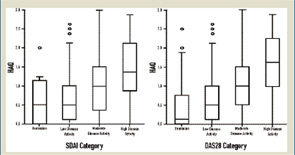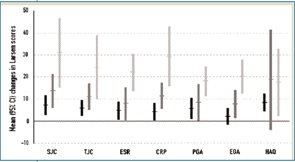

Source: Rheumatology. 2006;45:1133-1139.
When one strives for remission, one is aiming to achieve a disease a state (or disease activity category) rather than a mere proportional improvement. This means that patients with high disease activity have to experience larger changes than patients with moderate or low disease activity. Remission is associated with a much smaller reduction of inflammatory load in patients with moderate disease activity than patients with high disease activity. Striving for remission requires rethinking our attitude toward therapeutic goals and standards.
But how do we best measure remission?
Criteria for Remission
Remission may be defined on the basis of individual categorical terms or composite indices. The ACR remission criteria call for the fulfillment of five of six requirements.18 (See Table 1, right.) In the modified ACR criteria, fatigue has been omitted, and four of the five remaining characteristics need to be present to accomplish remission.19 The ACR criteria allow for any of the individual variables—including joint counts—to have highly abnormal values as long as the other five (or four) have normalized.20
